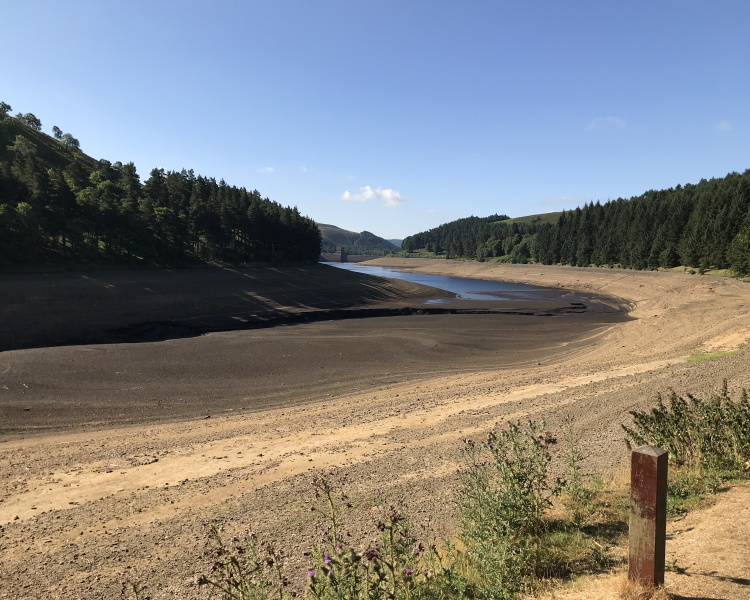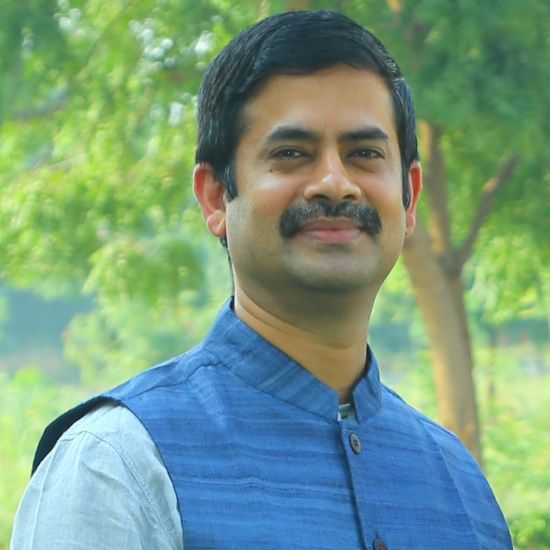Links to external sources may no longer work as intended. The content may not represent the latest thinking in this area or the Society’s current position on the topic.
Drought risk in the Anthropocene

Science+ meeting organised by Professor Jim Hall FREng, Associate Professor Jamie Hannaford and Professor Gabriele Hegerl FRS.
The impacts of droughts on people and the natural environment are increasing, due to climate change and over-exploitation of water resources. This Science+ meeting explored scientific understanding of changing drought risk and examined drought impacts on the environment, people and the economy. Policy-makers, practitioners and scientists discussed policy options for management of droughts in the future.
An accompanying journal issue has been published in Philosophical Transactions of the Royal Society A.
Attending the event
This meeting has taken place.
Enquiries: contact the Scientific Programmes team
Organisers
Schedule
Chair

Professor Gabriele Hegerl FRS

Professor Gabriele Hegerl FRS
Gabriele Hegerl is professor of climate system science at the University of Edinburgh. Prior to coming to Edinburgh, she has been at the Max-Planck Institute for Meteorology in Germany, and the University of Washington, Texas A&M and Duke University in the US. Her research focuses on understanding the causes of climate change and using observations to constrain predictions of future climate change. Her work has determined causes of change in temperature, rainfall, and extreme events and she had key roles in Intergovernmental Panel on Climate Change assessments of climate change. Gabriele is a fellow of the Royal Society.
| 08:00 - 08:10 |
Welcome on behalf of the Royal Society and by Professor Jim Hall FREng

Professor Jim Hall FREng

Professor Jim Hall FREngJim Hall FREng is Professor of Climate and Environmental Risks in the University of Oxford and is Director of Research in the School of Geography and the Environment. Before joining the University of Oxford in 2011 to become Director of the University's Environmental Change Institute, Jim held academic positions in Newcastle University and the University of Bristol. He is internationally recognised for his research on risk analysis and decision making under uncertainty for water resource systems, flood and coastal risk management, infrastructure systems and adaptation to climate change. Jim is a member of the Prime Minister's Council for Science and Technology, Commissioner of the National Infrastructure Commission and Vice President of the Institution of Civil Engineers. He was a member of the Adaptation Sub-Committee of the UK Climate Change Committee from 2009 to 2019 and was Chair of the Science Advisory Committee of the International Institute for Applied Systems Analysis (IIASA) from 2020-2022. Amongst various distinctions, Jim was awarded the George Stephenson Medal from the Institution of Civil Engineers in 2001 and the Prince Sultan Bin Abdulaziz International Prize for Water in 2018. Jim was a Contributing Author to the Nobel Prize-winning Fourth Assessment Report of the Intergovernmental Panel on Climate Change. |
|---|---|
| 08:10 - 08:30 |
Drought risk in the Anthropocene: from the Jaws of Death to the Waters of Life
In his opening address, Sir James Bevan, Chief Executive of the Environment Agency, will set the scene on the Anthropocene: looking at what this new epoch means for humans and nature, how we got here, and where we need to go next. Sir James’ speech will set out the alarming impact that the epoch’s most important feature, climate change caused by human activity, is having on drought risk and extreme weather. In response to these challenges Sir James will look ahead to COP26 and beyond, setting out what needs to be done to mitigate the worst impacts of runaway climate change, and to adapt to impacts that are irrevocable. In particular he will examine what needs to be done to escape what in 2019 he called ‘the Jaws of Death’, the point on water companies’ planning charts some 20 years from now where if we don’t intervene water demand will outstrip supply. He will set out what the Environment Agency is doing alongside business, government, civil society, and what the Royal Society can do to help. Finally he will argue why we should be optimistic we can turn the climate crisis into an opportunity that creates a better place for all. 
Sir James Bevan, Environment Agency England, UK

Sir James Bevan, Environment Agency England, UKSir James Bevan joined the Environment Agency (EA) as Chief Executive in late November 2015. Sir James has had a long career in government. His previous roles include: UK High Commissioner to India; Chief Operating Officer, UK Foreign Office; Visiting Fellow, Center for International Affairs, Harvard. He has also held a number of senior posts in the Foreign and Commonwealth Office including posts in Washington, Paris and Brussels. Sir James has a BA Honours in Social Anthropology from the University of Sussex. He was made a Companion of the Order of St Michael and St George (CMG) in 2006 and was awarded a Knighthood in 2012. Sir James was also awarded an Honorary Doctorate by Sussex University in 2012. |
| 08:30 - 08:45 | Discussion |
| 08:45 - 09:15 |
Global drought trends and future projections
Drought is one of the most difficult natural hazards to be measured and monitorised, which strongly affects the assessment of recent drought changes and future scenarios. This talk first illustrates some key conceptual issues, which are necessary to be considered when assessing drought changes and related uncertainties; among them it includes the need of considering the different behaviour of different drought types. Secondly, it shows trends in meteorological droughts considering a long-term perspective using precipitation records and also the possible role of global warming processes on trends in drought severity. Finally, the talk shows a review of studies analysing drought projections for future climate scenarios and it stresses the key concepts and uncertainties that are necessary to consider when assessing drought processes under climate change, including the use of different metrics and modelling approaches. The necessity of establishing differences between the behaviour of the mean climate and the frequency, duration, and spatial extent of droughts, considered as an extreme natural hazard, are emphasised when determining drought changes and future projections. 
Dr Sergio M Vicente-Serrano, Instituto Pirenaico de Ecología, Consejo Superior de Investigaciones Científicas (IPE-CSIC), Spain

Dr Sergio M Vicente-Serrano, Instituto Pirenaico de Ecología, Consejo Superior de Investigaciones Científicas (IPE-CSIC), SpainSergio M Vicente-Serrano is Scientific Researcher at the Pyrenean Institute of Ecology, a Research Centre of the Spanish National Research Council based in Zaragoza (Spain). Main activity of Sergio is the scientific research on different topics related to global change, including the study of landscape and vegetation changes in the Mediterranean region and different hydrological and climatic processes analysed on different spatial and temporal scales. Specifically, he has studied the influence of atmospheric circulation mechanisms on water resources availability, the assessment of climate change from an observational point of view, and the study of droughts from different perspectives, including the development of drought indices to improve the quantification of this complex phenomenon, and the assessment of drought impacts on environments and water resources. Sergio has coordinated different research projects at the European level and, in collaboration with stakeholders and water managers, participated in projects of adaptation to the climate change in different regions of Spain. He has published more than 300 scientific documents, including more than 200 articles in international journals of the fields of water resources, atmospheric sciences, remote sensing, etc. He has also developed different climate services and products, including a drought monitoring system with global coverage, participated as lead author for the sixth assessment report of the IPCC and member of the Science-Policy Interface of the UNCCD. |
| 09:15 - 09:30 | Discussion |
| 09:30 - 10:00 | Coffee break |
| 10:00 - 10:30 |
Droughts in a changing climate: Evidence from the IPCC AR6
This presentation will provide an overview of the main conclusions of the 6th Assessment report (AR6) from the Intergovernmental Panel on Climate Change (IPCC) on observed and projected changes in droughts. For the first time, a full chapter of the IPCC assessment report (Chapter 11; Seneviratne, Zhang, et al, in press) was dedicated to the topic of weather and climate extremes, including extensive assessments on changes in droughts. The drought assessment was subdivided in changes in meteorological, agricultural and ecological, and hydrological droughts. It was also informed from cross-chapter assessments with AR6 chapters assessing changes in a) the water cycle (Chapter 8), b) climatic impact drivers (Chapter 12), and the c) carbon cycle (Chapter 5), as well as d) the Atlas chapter. Regional assessments were also provided for all considered AR6 regions. Observations reveal that agricultural and ecological droughts have increased in several regions, and that human influence has contributed to increases in some regions due to increases in evapotranspiration. With every increment of global warming, changes in agricultural and ecological droughts become larger in several regions, including West-Central Europe and the Mediterranean region, as well as the Amazon region, among others. 
Professor Sonia I Seneviratne, ETH Zurich, Switzerland

Professor Sonia I Seneviratne, ETH Zurich, SwitzerlandSonia Seneviratne is Professor at the Institute of Atmospheric and Climate Science at ETH Zurich since 2007. She did her PhD thesis in 2003 at ETH Zurich and was a Postdoctoral scientist at NASA/Goddard Space Flight Center. Her research addresses climate change and extreme events, land-climate interactions, and terrestrial water processes. She was a Coordinating Lead Author and Lead Author on several IPCC reports, including the IPCC Special Report on Extreme events (SREX), the IPCC Special Report on 1.5°C Global warming, and the IPCC 6th Assessment report. Sonia Seneviratne belongs to the most cited scientists in her field and ranked 9th on Reuters 'hot list' of climate scientists. She received several awards for her research, including a Consolidator Grant from the European Research Council (2014), the Macelwane Medal from the American Geophysical Union (2013), and the Hans Oeschger Medal from the European Geosciences Union (2021). |
| 10:30 - 11:00 |
Did aerosols delay the emergence of greenhouse gas-forced drought in Southwestern North America?
Greenhouse gas emissions have likely contributed to current drought conditions in southwestern North America, which is experiencing one of its driest periods on record. But greenhouse gas emissions have risen steadily since the beginning of the Industrial Revolution: why then, have these drought conditions only emerged recently? In fact, in the latter part of the twentieth century regional soil moisture anomalies were unprecedentedly wet. In this talk, Dr Marvel will present a Bayesian method for detection and attribution that quantifies uncertainties, handles multiple external forcings, and can be used for model evaluation. The evidence suggests that aerosol forcing, aided by the eruption of Pinatubo in 1991, partially counteracted greenhouse gas-driven decreases in soil moisture, delaying the emergence of the current anthropogenically forced drought. 
Dr Kate Marvel, NASA Goddard Institute for Space Studies and Center for Climate Systems Research, Columbia University, USA

Dr Kate Marvel, NASA Goddard Institute for Space Studies and Center for Climate Systems Research, Columbia University, USADr Marvel uses climate models, observations, paleoclimate reconstructions, and basic theory to study climate change. Her work has identified human influences on present-day cloud cover, rainfall patterns, and drought risk. She is also interested in future climate changes, particularly climate feedback processes and the planet's sensitivity to increased carbon dioxide. Dr Marvel teaches in Columbia's MA in Climate and Society Program and writes the Hot Planet column for Scientific American. Named one of "15 Women Who Will Save the World" by Time Magazine, she has been profiled by the New York Times and Rolling Stone, and her 2017 TED talk has been viewed over one million times. Before becoming a climate scientist, she received a PhD in theoretical particle physics from Cambridge University, where she was a Gates scholar. |
| 11:00 - 11:30 | Discussion |
Chair

Dr Christel Prudhomme, ECMWF, UK

Dr Christel Prudhomme, ECMWF, UK
Christel Prudhomme is an expert in hydrological extreme, leading the Environmental Forecasts team at the European Centre for Medium-range Weather forecast. She directs the hydrological forecast computing centre of the Copernicus Emergency Management Centre, being responsible for the scientific development, operational maintenance and delivery of the CEMS Early Warning Systems on floods, the European Flood Awareness System and the Global Flood Awareness Systems EFAS and GloFAS. During her 25 years career, she has been leading research to study, understand and model the development in time and space of hydrological extremes (floods and droughts) across spatial scales (from local to global). One of the focus of her research was to assess their associated uncertainty and to quantifying the impact of climate variability and change on the hydrological processes. Christel is also Visiting Professor in Hydro-climatology at Loughborough University, UK, and a Research Fellow of the UK Centre for Ecology and Hydrology.
| 12:30 - 13:00 |
Status and Prospects of Drought Forecasting
Improving water supply management and decision making in water stressed regions requires reliable seasonal drought prediction, which remains a grand challenge. Over the past decades, a wide range of models, including dynamical, statistical and hybrid dynamical-statistical, have been developed for seasonal precipitation forecasting. However, each type has its own advantages and disadvantages. This presentation offers a review of progress in different types of forecasting methods including numerical/dynamical (eg, North American Multi-Model Ensemble), statistical models (eg, analog-based, ensemble streamflow prediction, artificial intelligence), and hybrid approaches that combine the two. This talk will review different hybrid frameworks such as hierarchical and parallel model concepts. The presentation ends with a discussion on current gaps and opportunities including satellite observations and artificial intelligence techniques. 
Professor Amir AghaKouchak, University of California, Irvine, USA

Professor Amir AghaKouchak, University of California, Irvine, USAAmir AghaKouchak is a Professor of Civil and Environmental Engineering and Earth System Science at the University of California, Irvine. His research focuses on natural hazards and climate extremes and crosses the boundaries between hydrology, climatology, and remote sensing. One of his main research areas is studying and understanding the interactions between different types of climatic and non-climatic hazards including compound and cascading events and their societal impacts. He has received several honors and awards including the American Geophysical Union’s James B. Macelwane Medal, Fellow of AGU, and the American Society of Civil Engineers (ASCE) Huber Research Prize. Amir is currently serving as the Editor-in-Chief of Earth’s Future. He has served as the principal investigator of several interdisciplinary research grants funded by the National Aeronautics and Space Administration (NASA), National Science Foundation (NSF), and National Oceanic and Atmospheric Administration (NOAA). |
|---|---|
| 13:00 - 13:30 |
Recent advances in drought monitoring using satellites and models

Professor Justin Sheffield, University of Southampton, UK

Professor Justin Sheffield, University of Southampton, UKJustin Sheffield is a Professor of Hydrology and Remote Sensing at the University of Southampton, UK. His research is on fundamental and applied research on large-scale hydrology and its interactions with climate variability and change. He has published extensively on hydrological extremes, climate change, and hydrological processes from catchment to global scale, and on the application of research to natural hazards impacts reduction, and water and food security particularly in developing regions, including monitoring and prediction systems. He has received a number of awards including the Prince Sultan Bin Abdulaziz International Prize for Water in 2014 for research work on drought monitoring and prediction, and the Plinius Medal of the European Geosciences Union in 2013 for multi-disciplinary research and applications in hydrological hazards. Most recently he was named as the 2019 Robert E. Horton Lecturer in Hydrology by the American Meteorological Society for advancing hydrologically coherent analyses of drought across time and space scales, and for pioneering the development of integrated drought monitoring tools for food-insecure countries. |
| 13:30 - 14:00 | Discussion |
| 14:00 - 14:30 | Tea break |
| 14:30 - 15:00 |
UK droughts past, present and future: quantifying hydroclimatic variability to inform drought management
Water resource managers need to understand hydroclimatic variability to manage droughts. For long-term planning it is essential to understand drought risk, based on past recorded variability and what is likely to happen in future. For managing drought events in the here and now, it is necessary to understand current water availability status, and what is likely to happen over the coming weeks and months. While the UK has a long history of water resources management and well-evolved frameworks for drought planning, at the same time there are inevitable limitations: our understanding of the past is constrained by short observational records, while the utility of future forecasts and projections (whether seasonal or multi-decadal) is inevitably constrained by the uncertainties involved in climate and hydrological modelling. This presentation focuses on recent advances in our understanding of drought variability, largely drawn from the UKRI Drought and Water Scarcity Programme (2014 – 2020). This will include efforts to extend our understanding of past drought variability through hydroclimatic reconstructions, initiatives to provide national-scale, spatially coherent hydrological projections for the 21st century, and the latest advances in status monitoring and seasonal forecasting. Several key themes run through all this work: notably the importance, and challenges, of drought definition and quantification; and the importance of co-development with diverse end-users to ensure the applicability of hydroclimate services in drought management on-the-ground. 
Associate Professor Jamie Hannaford, UK Centre for Ecology & Hydrology and Maynooth University, UK and Ireland

Associate Professor Jamie Hannaford, UK Centre for Ecology & Hydrology and Maynooth University, UK and IrelandJamie is a hydrologist with over 20 years’ experience in hydrological research. He leads the Hydrological Status and Outlooks Group at the UK Centre for Ecology & Hydrology and is a visiting Associate Professor at the Irish Climate And Research Units (ICARUS) at Maynooth University in Ireland. His specialisation is in the analysis of hydrological extremes (floods and droughts) and he has published over 80 peer-reviewed publications in this area. He is the scientific lead for the water monitoring component of UKCEH’s National Capability funded research programme (which includes the National River Flow Archive, the National Hydrological Monitoring Programme and Hydrological Outlook). He has led a number of major UK drought research projects including the NERC-funded Historic Droughts (2014 – 2018), ENDOWS (2017-2019) and DrIVER (2014-2017) projects aimed at drought characterisation, monitoring, management and adaptation. He has also led international droughts research projects, including in China, India and Thailand. Much of his work has been focused on practical applications and in this regard he has worked with diverse stakeholders and end-users across many sectors (water supply, regulation, agriculture, conservation, power generation and so on). |
| 15:00 - 15:30 |
Benchmark worst droughts in India (1901-2020)
During the summer monsoon (June-September) season, drought poses challenges for agricultural activities and water availability in India. We develop a framework considering the timing, areal coverage, and severity of droughts that can be used for the assessment as the monsoon season progresses. We estimate the benchmark worst droughts within the monsoon season (June, July, August, and September) using the long-term (1901-2020) gridded rainfall. The benchmark worst droughts were identified considering the extent and severity of drought using the Drought Severity Coverage Index (DSCI). The worst meteorological droughts in June, July, August, and September occurred in 1923, 2002, 1937, and 1907 with a return period of 68, 200, 147, 188 years, respectively. The worst drought in the entire summer monsoon season occurred in 1918, which had a return period of 238 years. The benchmark droughts during June 1923, July 2002, and monsoon 1918 were associated with the warm SST over the equatorial Pacific Ocean. The other two droughts (1937 and 1907) were linked with the off-equatorial warming over the Indo-Pacific region. The estimated DSCI for a 2-500 return period can be used for the drought assessment during the monsoon season in India. 
Dr Vimal Mishra, Indian Institute of Technology (IIT) Gandhinagar, India

Dr Vimal Mishra, Indian Institute of Technology (IIT) Gandhinagar, IndiaDr Mishra is currently an Associate Professor in Civil Engineering and Earth Sciences at Indian Institute of Technology Gandhinagar. His research contributed to advancing our understanding of land-atmospheric coupling and its role on hydroclimatic extremes. For instance, he identified the role of intensive irrigation in India on atmospheric aridity, land surface temperature, dry and moist heat extremes, and droughts. He has contributed to developing a real-time monitoring and prediction system for soil moisture, streamflow, and droughts that are essential for managing the depleting water resources in India. He has contributed to improving our understanding of the risks of extreme weather events under the observed and future climate in India. He has co-authored more than 100 peer reviewed publications. He is currently serving as an editor of Earth’s Future (AGU) and Associate Editor of Journal of hydrology. |
| 15:30 - 16:00 | Discussion |
| 16:00 - 17:30 | Poster session |
Chair

Professor Jim Hall FREng

Professor Jim Hall FREng
Jim Hall FREng is Professor of Climate and Environmental Risks in the University of Oxford and is Director of Research in the School of Geography and the Environment. Before joining the University of Oxford in 2011 to become Director of the University's Environmental Change Institute, Jim held academic positions in Newcastle University and the University of Bristol. He is internationally recognised for his research on risk analysis and decision making under uncertainty for water resource systems, flood and coastal risk management, infrastructure systems and adaptation to climate change.
Jim is a member of the Prime Minister's Council for Science and Technology, Commissioner of the National Infrastructure Commission and Vice President of the Institution of Civil Engineers. He was a member of the Adaptation Sub-Committee of the UK Climate Change Committee from 2009 to 2019 and was Chair of the Science Advisory Committee of the International Institute for Applied Systems Analysis (IIASA) from 2020-2022.
Amongst various distinctions, Jim was awarded the George Stephenson Medal from the Institution of Civil Engineers in 2001 and the Prince Sultan Bin Abdulaziz International Prize for Water in 2018. Jim was a Contributing Author to the Nobel Prize-winning Fourth Assessment Report of the Intergovernmental Panel on Climate Change.
| 08:00 - 08:30 |
Agriculture and drought - from coping to adapting?
Droughts affect a range of economically important sectors but their impacts are usually most evident within agriculture. These impacts are not confined to arid and semi-arid regions, but are increasingly experienced in more temperate and humid regions. Agriculture is a highly heterogenous sector, with differing drought sensitivity and potential drought response options. This presentation will first consider how agriculture is affected by different types of drought and then, using research from Thailand and the UK, consider examples of reactive and adaptive drought responses implemented by farming and non-farming actors. Finally, the presentation will discuss how agriculture can transition to longer-term planning and investment that builds drought resilience through supporting both short-term coping responses and effective adaptation to future droughts. 
Professor Ian Holman, Cranfield University, UK

Professor Ian Holman, Cranfield University, UKIan Holman is Professor of Integrated Land and Water Management at Cranfield University where he leads the Catchment Management Community of Practice within the Cranfield Water Science Institute. He takes an interdisciplinary perspective to sustainable land and water resource management, drought risk management and climate change impacts and adaptation research in the UK, Europe and internationally. Working closely with stakeholders, his recent research spans understanding historical drought impacts in the UK and Thailand (HistoricDroughts, STAR), modelling current and future drought risks to irrigated agriculture (MaRIUS), developing innovative decision-support tool for improving drought risk and abstraction management (DRisk, DRisk2) and the agricultural knowledge exchange component (ENDOWS) of the UKRI Drought and Water Scarcity programme. |
|---|---|
| 08:30 - 09:00 |
Understanding the transgression of global and regional freshwater planetary boundaries
Freshwater ecosystems have degraded over the past decades as a result of intense freshwater abstraction. Therefore, environmental flow requirements (EFRs) methods have been proposed to maintain healthy rivers and/or restore river flows. In this study, Dr Pastor and her colleagues used the Variable Monthly Flow method with two thresholds (normal and high) to calculate EFRs on a global scale. They propose a novel method to calculate the transgression of freshwater planetary boundaries by accounting for water deficit with refined spatial (0.5°) and temporal scales: (1) climate deficits in which flow does not meet EFRs due to climate variability/climate change, and (2) anthropogenic deficit caused by water abstractions. Compared to previous assessments, they calculated cumulative monthly water deficit in different types of rivers: intermittent and perennial with the frequency, magnitude and causes of environmental flow (EF) deficits. Results show that EF deficit is highly variable among river basins. Perennial rivers with low flow alteration such as the Amazon showed an EF deficit of 2-12% of the total discharge, and the climate deficit was responsible for up to 75% of the total deficit. In rivers with high seasonality and high water abstractions such as the Indus, the total deficit represents up to 130% of its total discharge, of which 85% is due to abstractions. 
Dr Amandine Valérie Pastor, Institut national de recherche pour l’agriculture, l’alimentation et l’environnement, France

Dr Amandine Valérie Pastor, Institut national de recherche pour l’agriculture, l’alimentation et l’environnement, FranceAmandine Pastor is a researcher at INRAE working on the integration of ecosystem services and spatial dimensions of water and carbon to life cycle analysis. Before, she has spent some time at the Faculty of Science in Lisbon working for the H2020 LOCOMOTION project to integrate of water and land dynamics into an Integrated Assessment Models based on the use of renewable energy. She is an agriculture engineer with a PhD in hydrology from Wageningen University (the Netherlands). She worked on the impact of global change on water resources and the different trade-off between environmental flows and food security. She is specialised in earth system modelling, climate change and ecosystem services. She also has fieldwork experiences in sustainable agriculture and soil and water conservation projects in Europe and overseas. |
| 09:00 - 09:30 |
Causes of Hydrological Drought and the Consequences for Resilience in the Northern Murray-Darling Basin, Australia
Climate change modelling projects increases in potential evapotranspiration, notwithstanding projected increases in global land precipitation. This has fundamental implications for managing water within catchments, requiring to sustainably balance water allocations for competing users, especially in semi-arid and arid environments. Using meteorological and hydrological data from gauging stations in the northern Murray-Darling Basin (MDB) of south-eastern Australia, Professor Grafton and his colleagues evaluated the possible causes and consequences of measured reductions in streamflows at Caiwarro (Paroo River) and Wilcannia (Lower Darling River). In conjunction, they analysed fluctuations in waterbird adundance estimated from aerial surveys between 1983 and 2020. They find: (1) drying trends and reduced streamflows at Caiwarro and Wilcannia; (2) streamflow declines at Wilcannia, adjacent to Menindee Lakes, cannot be attributed to climate change alone; (3) waterbird diversity and abundance have declined at Menindee Lakes with streamflow decline and substantially more than the recorded declines at RAMSAR Paroo national wetlands, downstream of Caiwarro; (4) resilience, as measured by resistance and recovery time, of waterbird abundance to droughts is greater in the Paroo national wetlands compared to Menindee Lakes; and (5) reductions in upstream water extractions increase waterbird resilience and the costs of these mitigating measures vary from A$24m to A$75m. 
Professor R Quentin Grafton, Australian National University, Australia

Professor R Quentin Grafton, Australian National University, AustraliaQuentin Grafton is Professor of Economics and Chairholder UNESCO Chair in Water Economics and Transboundary Water Governance at the Australian National University (ANU) and a Distinguished Visiting Professor at Tsinghua University. He is an Australian Laureate Fellow, a Fellow of the Academy of Social Sciences in Australia, a former President (2017-18) of the Australasian Agricultural and Resource Economics Society (AARES) and a Distinguished Fellow of AARES. He is currently the Convenor of the Water Justice Hub, the Editor in Chief of the Global Water Forum and Policy Forum, and is the Director of the Food, Energy, Environment and Water (FE2W) Network. |
| 09:30 - 10:00 | Discussion |
| 10:00 - 10:30 | Coffee break |
| 10:30 - 11:30 |
Panel discussion: Preparing for and managing droughts

Mr Peter Simpson, Anglian Water, UK

Mr Peter Simpson, Anglian Water, UKPeter has been Chief Executive of Anglian Water Group since October 2013. He is a founding member, and now Co-chair, of the UK Corporate Leaders Group in the UK, run by the University of Cambridge Institute for Sustainability Leadership, which provides a strong voice to support UK leadership nationally and internationally on the transition to a climate neutral, resource efficient, socially inclusive economy by 2050. He works with Business in the Community and is Chair of the East of England Leadership Team. He also sits on the Board of Trustees of WaterAid. Peter is a Chartered Water and Environmental Manager, a Chartered Scientist and a Chartered Environmentalist. In 2016 he was made an Honorary Fellow of the Society of the Environment and an Honorary Fellow of the Chartered Institution of Water and Environmental Management. He holds an MBA from Warwick Business School. Peter was Chairman of Water UK from April 2012 to October 2013 and is a past President of the Institute of Water. 
Dr Dave Tickner, WWF, UK

Dr Dave Tickner, WWF, UKDave Tickner is Chief Freshwater Adviser at WWF, based near London. He advises international river and water management programmes, leads a research portfolio, and engages governments, international organisations and companies on sustainability issues. Dave previously worked in the UK’s environment ministry before completing a PhD in freshwater sciences and then directing WWF’s Danube River programme. He has held non-executive and advisory roles in the private sector and is currently also a Visiting Researcher at the University of East Anglia, an Associate Editor of the academic journal Frontiers in Environmental Science, and a member of the UK government’s Darwin Expert Committee. 
Dr Xavier Leflaive, OECD, France

Dr Xavier Leflaive, OECD, FranceXavier Leflaive leads the work on Resilience, Adaptation to climate change and Water in the OECD Environment Directorate. The programme of work aims to support governments for the design, implementation and financing of policies that contribute to water security and adaptation to a changing climate. On-going projects cover measuring adaptation, adaptation finance, wildfires management, nature-based solutions and climate-resilient infrastructure, financing water, and water & health. Xavier joined the OECD in 2004. He coordinated the Recommendation of the OECD Council on water, which captures OECD policy guidance on the management of water resources, water supply and sanitation services, and water-related risks. He has facilitated policy reforms in Brazil, Korea, Europe, the Caucasus and Central Asia. Xavier Leflaive studied business administration and social theory in France, Canada and the UK. He holds a PhD in Social and Political Sciences from the University of Cambridge, UK. 
Mr Jonson Cox CBE, Ofwat, UK

Mr Jonson Cox CBE, Ofwat, UKJonson has been Chairman of Ofwat since November 2012. He has played a strong part in the work to bring the water sector back to a core customer and public service focus, while retaining an attractive proposition for investors. He has a background as CEO and Chairman in regulated and commercial infrastructure, with a focus on turnarounds and restructuring. After an early career with Royal Dutch/Shell Group, Jonson served as Managing Director of Yorkshire Water (1996-2000) to lead the company out of a significant crisis with its customers and restore YW’s top-ranking status in the industry. After other infrastructure roles, he returned to the water sector for over six years, 2004 – 2010, as Group CEO at troubled AWG plc. He led the successful turnarounds of underperforming Anglian Water Services, Morrison plc and Anglian Water International, recovering from the multiple business difficulties the Group faced. Jonson led the restructuring of UK Coal plc as Executive Chairman, (2010 to 2012) to bring a managed 'soft close' to coalmining in the UK. He secured the value in UKC’s property development business for investors and the PPF, which was listed as Harworth plc. He served as inaugural Chairman from 2012 to 2018. He joined Cory Group, owner of the UKs largest waste-to-energy plant, as Chairman when lenders took control in 2015 and led the board though the recovery and successful sale to infrastructure funds in 2018. He serves on the global policy council of I Squared Capital and is an NED at Energia, the Irish energy group, and Ovo, the UK energy retailer. 
Dr Giriraj Amarnath, International Water Management Institute, Sri Lanka

Dr Giriraj Amarnath, International Water Management Institute, Sri LankaGiriraj Amarnath is a Principal Research – Disaster Risk Management and Climate Resilience and Research Group Leader: Water Risks to Development and Resilience of the International Water Management Institute (IWMI). His role focuses on climate risk assessment, monitoring and early warning tools using earth observation data and modeling tools, and the development of disaster risk insurance solutions. Dr Giriraj began his career as a remote sensing expert at the University of Bayreuth, Germany and was a disaster risk specialist for the International Centre for Integrated Mountain Development at Kathmandu. He recently won the World Geospatial Excellence Award and 2020 GEO SDG Award in promoting innovative solutions in managing floods and drought using digital tools. Dr Giriraj holds a PhD in Applied remote sensing from the National Remote Sensing Centre, India, and an MSc in Geoinformatics and Botany from the University of Madras. 
Mr Davide Minotti, Defra (Department for Environment, Food and Rural Affairs), UK

Mr Davide Minotti, Defra (Department for Environment, Food and Rural Affairs), UKDavide Minotti is Deputy Director for Water Services in Defra, responsible for relationship with water industry and water regulators as well as water efficiency. Prior to this, Davide has led work across Government on developing and introducing to Parliament the Environment Bill, on environment regulations and EU Exit and on leading Defra’s work in response to COVID-19. He has worked in Defra on a number of policy areas from air quality to waste and resource efficiency, climate change, forestry and international sustainable development. Outside Defra, Davide has worked for the Prime Minister’s Delivery Unit on Civil Service reform, at the European Commission on energy and resource efficiency and as consultant in the private sector. |
Chair

Associate Professor Jamie Hannaford, UK Centre for Ecology & Hydrology and Maynooth University, UK and Ireland

Associate Professor Jamie Hannaford, UK Centre for Ecology & Hydrology and Maynooth University, UK and Ireland
Jamie is a hydrologist with over 20 years’ experience in hydrological research. He leads the Hydrological Status and Outlooks Group at the UK Centre for Ecology & Hydrology and is a visiting Associate Professor at the Irish Climate And Research Units (ICARUS) at Maynooth University in Ireland. His specialisation is in the analysis of hydrological extremes (floods and droughts) and he has published over 80 peer-reviewed publications in this area. He is the scientific lead for the water monitoring component of UKCEH’s National Capability funded research programme (which includes the National River Flow Archive, the National Hydrological Monitoring Programme and Hydrological Outlook). He has led a number of major UK drought research projects including the NERC-funded Historic Droughts (2014 – 2018), ENDOWS (2017-2019) and DrIVER (2014-2017) projects aimed at drought characterisation, monitoring, management and adaptation. He has also led international droughts research projects, including in China, India and Thailand. Much of his work has been focused on practical applications and in this regard he has worked with diverse stakeholders and end-users across many sectors (water supply, regulation, agriculture, conservation, power generation and so on).
| 12:30 - 13:00 |
The risks of droughts for public water supplies
Increasing pressures on water supplies, from climate change and population growth mean that there is an ever-growing need to examine the resilience of public water supplies. Traditional methods for balancing water supply and demand do not explicitly examine system performance during extreme drought events. Analysing the resilience of public water supplies requires dynamical simulation of system performance before, during and after extreme events. The water supply system in England and Wales is very complex, involving multiple catchments, transfers and regulation. System resilience therefore needs to be analysed over broad scales, taking full account of these complex interdependencies. Having not seen major new strategic resource investment since the 1980s, a series of strategic resource options, including major inter-basin transfers and storage reservoirs, are now under consideration. This raises questions about the resilience of these new supplies, in the context of extreme and widespread droughts. This presentation will explore the limits to adaptation in this system, when multiple strategic water resource options are used in combination. Under what conditions will these new strategic options cease to provide resilient water supplies, and how can they be operated to enhance resilience? The analysis will make use of a coupled system of regional climate model simulations, national hydrological modelling and national water resource system simulation modelling. 
Professor Jim Hall FREng

Professor Jim Hall FREngJim Hall FREng is Professor of Climate and Environmental Risks in the University of Oxford and is Director of Research in the School of Geography and the Environment. Before joining the University of Oxford in 2011 to become Director of the University's Environmental Change Institute, Jim held academic positions in Newcastle University and the University of Bristol. He is internationally recognised for his research on risk analysis and decision making under uncertainty for water resource systems, flood and coastal risk management, infrastructure systems and adaptation to climate change. Jim is a member of the Prime Minister's Council for Science and Technology, Commissioner of the National Infrastructure Commission and Vice President of the Institution of Civil Engineers. He was a member of the Adaptation Sub-Committee of the UK Climate Change Committee from 2009 to 2019 and was Chair of the Science Advisory Committee of the International Institute for Applied Systems Analysis (IIASA) from 2020-2022. Amongst various distinctions, Jim was awarded the George Stephenson Medal from the Institution of Civil Engineers in 2001 and the Prince Sultan Bin Abdulaziz International Prize for Water in 2018. Jim was a Contributing Author to the Nobel Prize-winning Fourth Assessment Report of the Intergovernmental Panel on Climate Change. |
|---|---|
| 13:00 - 13:30 |
The economics of managing water crises
The growing risk of water crises, including drought, is one of the greatest challenges in the coming decades. Averting such crises will be especially daunting, given that they are just as much a failure of water management as a result of scarcity. At the heart of global water mismanagement is the persistent underpricing of water. The increasing environmental and social costs associated with freshwater scarcity are not routinely reflected in markets. Nor have we developed adequate policies and institutions to handle these costs. This creates perverse incentives that fail to balance water use with supply, protect freshwater ecosystems and support necessary technological innovations. However, drought is proving to be a catalyst for governance and policy reform, and steps can be taken to overcome the underpricing of water. Several examples are explored to illustrate the problem and how to overcome it. They include employing water markets and trades to facilitate water conservation and re-allocation, increasing cost-effective delivery of clean water and sanitation in developing countries, and rationalising irrigation and other agricultural subsidies that lead to over-use and pollution of water. A comprehensive strategy for water-saving innovation is also discussed. 
Professor Edward Barbier, Department of Economics, Colorado State University, USA

Professor Edward Barbier, Department of Economics, Colorado State University, USAEdward B Barbier is a University Distinguished Professor in the Department of Economics, Colorado State University and a Senior Scholar in the School of Global Environmental Sustainability. His main expertise is environmental and resource economics as well as international environmental policy. He has consulted for a variety of national, international and non-governmental agencies, including many UN organizations, the World Bank and the OECD. He has authored over 300 peer-reviewed journal articles and book chapters, written or edited 26 books, and published in popular journals and social media. Barbier is a Fellow of the Association of Environmental and Resource Economists and is a highly cited scholar on global environmental and sustainability issues. He is the author of The Water Paradox: Overcoming the Global Crisis in Water Management. Yale University Press, New Haven and London. |
| 13:30 - 14:00 | Discussion |
| 14:00 - 14:30 | Tea break |
| 14:30 - 15:30 |
Panel discussion: concluding remarks and future directions

Dr Kate Marvel, NASA Goddard Institute for Space Studies and Center for Climate Systems Research, Columbia University, USA

Dr Kate Marvel, NASA Goddard Institute for Space Studies and Center for Climate Systems Research, Columbia University, USADr Marvel uses climate models, observations, paleoclimate reconstructions, and basic theory to study climate change. Her work has identified human influences on present-day cloud cover, rainfall patterns, and drought risk. She is also interested in future climate changes, particularly climate feedback processes and the planet's sensitivity to increased carbon dioxide. Dr Marvel teaches in Columbia's MA in Climate and Society Program and writes the Hot Planet column for Scientific American. Named one of "15 Women Who Will Save the World" by Time Magazine, she has been profiled by the New York Times and Rolling Stone, and her 2017 TED talk has been viewed over one million times. Before becoming a climate scientist, she received a PhD in theoretical particle physics from Cambridge University, where she was a Gates scholar. 
Paul Hickey, RAPID, UK

Paul Hickey, RAPID, UKPaul Hickey is the Managing Director of RAPID (Regulators Alliance Progressing Infrastructure Development) - a regulatory partnership between Ofwat, the Environment Agency and the Drinking Water Inspectorate. RAPID’s goal is facilitate the coordinated delivery of a programme of strategic water resource schemes required to meet the needs of people, the economy and our environment as set out in the National Water Resource Framework. RAPID will also test the regulatory and commercial arrangements for water resource infrastructure to ensure it is fit for future needs. Paul is seconded to RAPID from the Environment Agency where he was Deputy Director with oversight of Water Resources for England. Prior to the Environment Agency, Paul worked in the water industry in a variety of regulation and asset management roles. Paul is a Fellow of the Institute of Water and sits on its Board as well as the South West Area Committee. 
Dr Anne Van Loon, Institute for Environmental Studies, Vrije Universiteit Amsterdam, The Netherlands

Dr Anne Van Loon, Institute for Environmental Studies, Vrije Universiteit Amsterdam, The NetherlandsAnne Van Loon is an Associate Professor in Drought Risk within the Water & Climate Risk group at the Institute for Environmental Studies (IVM) at the Vrije Universiteit Amsterdam. She is a hydrologist and interdisciplinary drought (& flood) risk scientist, interested in the relationship between water, people and the environment. She uses mixed methods (quantitative and qualitative data analysis, modelling, workshops) to understand hydrological processes and their interaction with human activities, especially in relation to drought propagation, water management and changes in (ground)water use and vulnerability. Anne is currently leads the interdisciplinary ERC project on drought-to-flood disasters (PerfectSTORM) and is involved in projects related to drought and flood management in southern Africa (Connect 4 WR), groundwater drought in Europe (GDI), drought risk modelling in eastern Africa (DOWN2EARTH), and the EU-funded project RECEIPT on climate risk storylines. 
Professor Gabriele Hegerl FRS

Professor Gabriele Hegerl FRSGabriele Hegerl is professor of climate system science at the University of Edinburgh. Prior to coming to Edinburgh, she has been at the Max-Planck Institute for Meteorology in Germany, and the University of Washington, Texas A&M and Duke University in the US. Her research focuses on understanding the causes of climate change and using observations to constrain predictions of future climate change. Her work has determined causes of change in temperature, rainfall, and extreme events and she had key roles in Intergovernmental Panel on Climate Change assessments of climate change. Gabriele is a fellow of the Royal Society. 
Professor Len Shaffrey, National Centre for Atmospheric Science, University of Reading, UK

Professor Len Shaffrey, National Centre for Atmospheric Science, University of Reading, UKLen Shaffrey is a Professor of Climate Science in the Department of Meteorology at the University of Reading and the Theme Leader for Climate and High Impact Weather in the UK's National Centre for Atmospheric Science. His personal research focuses on the impact of climate variability and change on weather extremes such as storms, floods, and droughts, including improving seasonal to decadal climate forecasts. Len was the Lead Principal Investigator for the UK NERC IMPETUS project on the seasonal forecasting of UK droughts. 
Professor Amir AghaKouchak, University of California, Irvine, USA

Professor Amir AghaKouchak, University of California, Irvine, USAAmir AghaKouchak is a Professor of Civil and Environmental Engineering and Earth System Science at the University of California, Irvine. His research focuses on natural hazards and climate extremes and crosses the boundaries between hydrology, climatology, and remote sensing. One of his main research areas is studying and understanding the interactions between different types of climatic and non-climatic hazards including compound and cascading events and their societal impacts. He has received several honors and awards including the American Geophysical Union’s James B. Macelwane Medal, Fellow of AGU, and the American Society of Civil Engineers (ASCE) Huber Research Prize. Amir is currently serving as the Editor-in-Chief of Earth’s Future. He has served as the principal investigator of several interdisciplinary research grants funded by the National Aeronautics and Space Administration (NASA), National Science Foundation (NSF), and National Oceanic and Atmospheric Administration (NOAA). |
| 15:30 - 16:00 |
Closing remarks

Associate Professor Jamie Hannaford, UK Centre for Ecology & Hydrology and Maynooth University, UK and Ireland

Associate Professor Jamie Hannaford, UK Centre for Ecology & Hydrology and Maynooth University, UK and IrelandJamie is a hydrologist with over 20 years’ experience in hydrological research. He leads the Hydrological Status and Outlooks Group at the UK Centre for Ecology & Hydrology and is a visiting Associate Professor at the Irish Climate And Research Units (ICARUS) at Maynooth University in Ireland. His specialisation is in the analysis of hydrological extremes (floods and droughts) and he has published over 80 peer-reviewed publications in this area. He is the scientific lead for the water monitoring component of UKCEH’s National Capability funded research programme (which includes the National River Flow Archive, the National Hydrological Monitoring Programme and Hydrological Outlook). He has led a number of major UK drought research projects including the NERC-funded Historic Droughts (2014 – 2018), ENDOWS (2017-2019) and DrIVER (2014-2017) projects aimed at drought characterisation, monitoring, management and adaptation. He has also led international droughts research projects, including in China, India and Thailand. Much of his work has been focused on practical applications and in this regard he has worked with diverse stakeholders and end-users across many sectors (water supply, regulation, agriculture, conservation, power generation and so on). 
Professor Jim Hall FREng

Professor Jim Hall FREngJim Hall FREng is Professor of Climate and Environmental Risks in the University of Oxford and is Director of Research in the School of Geography and the Environment. Before joining the University of Oxford in 2011 to become Director of the University's Environmental Change Institute, Jim held academic positions in Newcastle University and the University of Bristol. He is internationally recognised for his research on risk analysis and decision making under uncertainty for water resource systems, flood and coastal risk management, infrastructure systems and adaptation to climate change. Jim is a member of the Prime Minister's Council for Science and Technology, Commissioner of the National Infrastructure Commission and Vice President of the Institution of Civil Engineers. He was a member of the Adaptation Sub-Committee of the UK Climate Change Committee from 2009 to 2019 and was Chair of the Science Advisory Committee of the International Institute for Applied Systems Analysis (IIASA) from 2020-2022. Amongst various distinctions, Jim was awarded the George Stephenson Medal from the Institution of Civil Engineers in 2001 and the Prince Sultan Bin Abdulaziz International Prize for Water in 2018. Jim was a Contributing Author to the Nobel Prize-winning Fourth Assessment Report of the Intergovernmental Panel on Climate Change. 
Professor Gabriele Hegerl FRS

Professor Gabriele Hegerl FRSGabriele Hegerl is professor of climate system science at the University of Edinburgh. Prior to coming to Edinburgh, she has been at the Max-Planck Institute for Meteorology in Germany, and the University of Washington, Texas A&M and Duke University in the US. Her research focuses on understanding the causes of climate change and using observations to constrain predictions of future climate change. Her work has determined causes of change in temperature, rainfall, and extreme events and she had key roles in Intergovernmental Panel on Climate Change assessments of climate change. Gabriele is a fellow of the Royal Society. |
